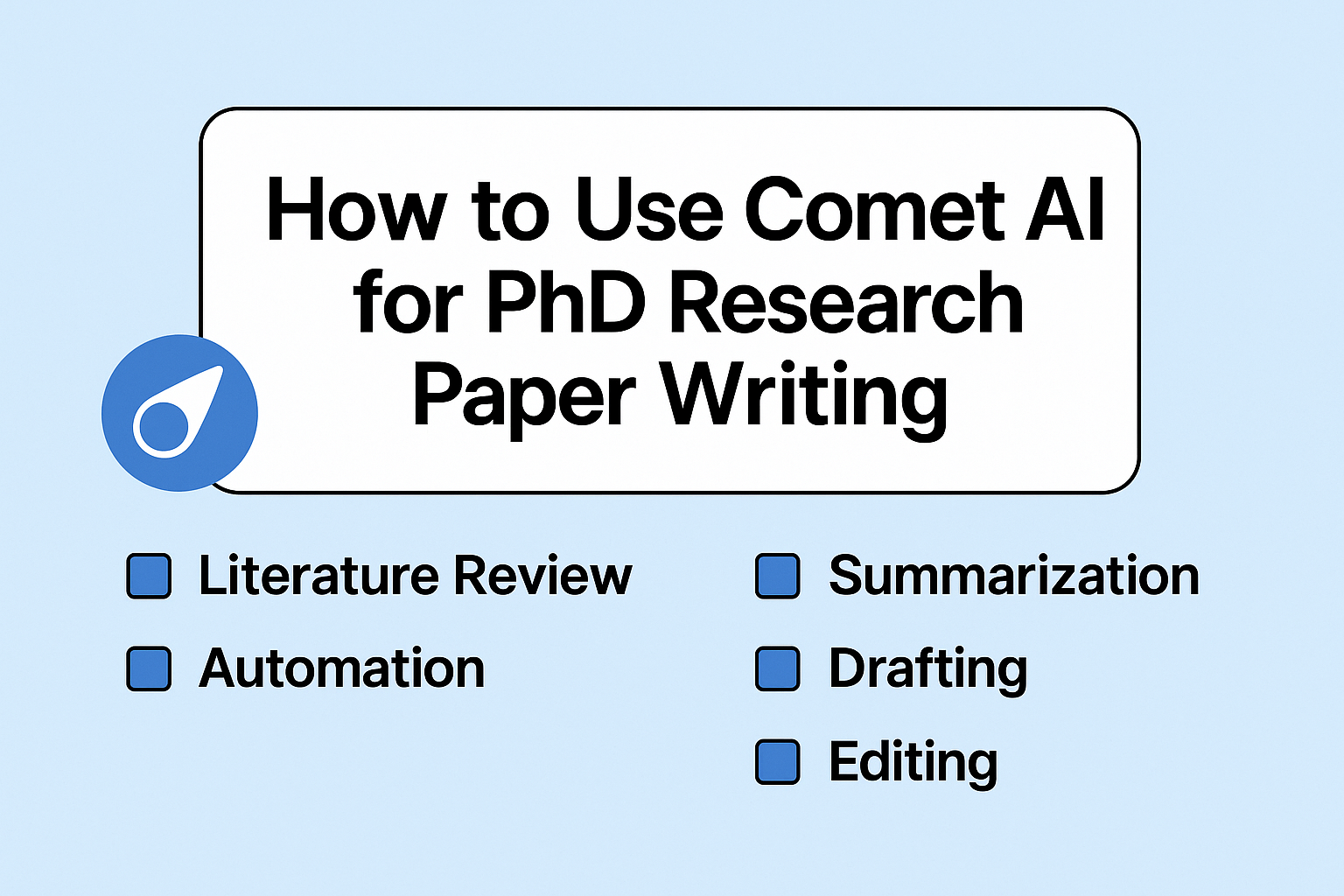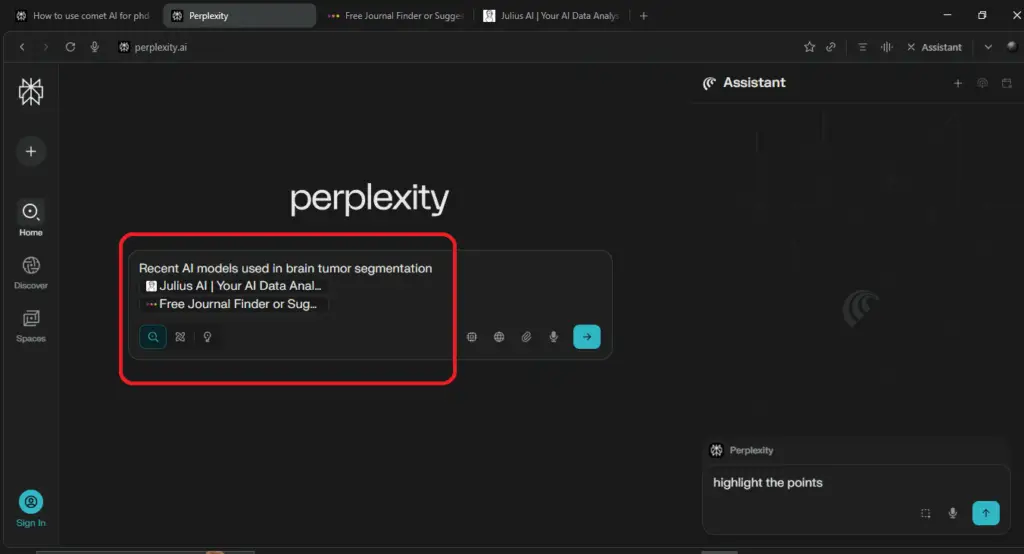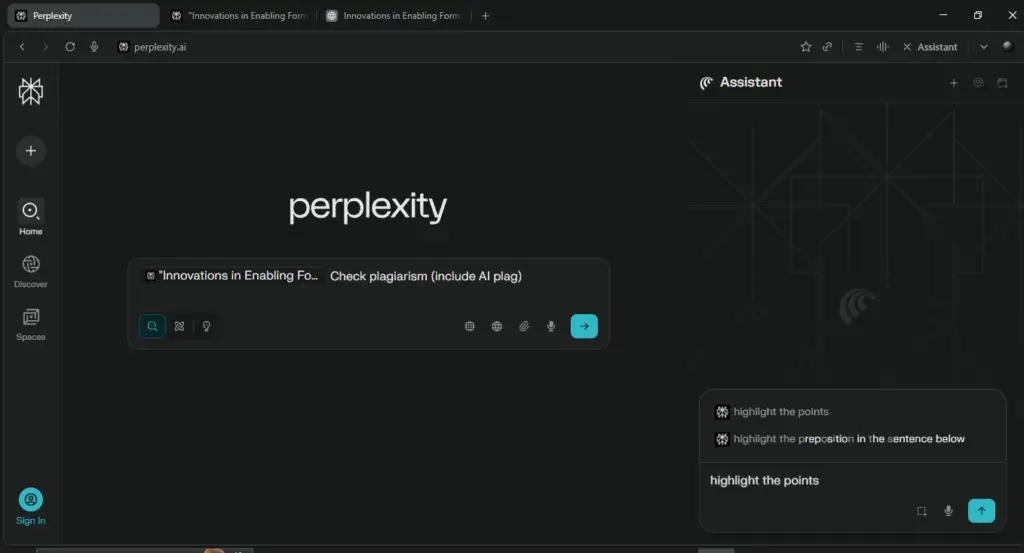Feeling overwhelmed by hundreds of open tabs, unread PDFs, and scattered notes? You’re not alone. PhD research writing is one of the most time-consuming academic tasks, and AI tools like Comet AI by Perplexity are now helping scholars speed up every stage of the process, from literature review to final proofreading. In this article, I have explained the entire process effectively using Comet AI for PhD Research Paper Writing.
What is Comet AI?
Comet AI is a Chromium-based browser powered by Perplexity, featuring a built-in AI research assistant. Unlike regular browsers or search engines, Comet is designed to automate academic research tasks through AI-powered summarization, topic tracking, and tool integration.
It offers:
- Smart search and summarization
- In-browser note-taking and organization
- Integration with tools like Trinka, Connected Papers, and Julius AI
- Automated workflows and scripting for repetitive research tasks
Key Benefits of Using Comet AI for PhD Research Writing
Here’s how Comet can assist at every step of your academic writing journey:

1. Automated Literature Review Workflows
You can automate literature review workflows using Comet AI integration by leveraging its AI-driven, agentic search, workflow automation, and contextual assistance, all built right into your browser.
Key Features:
- AI-Powered Topic Search
Just type your research question in plain English. Comet scans scholarly and open-web sources, providing summarized insights, not just links.
➤ Example: “Recent AI models used in brain tumor segmentation.”

- Real-Time Summarization
Upload PDFs or browse articles, and the assistant will summarize methodologies, results, and conclusions. Results can even be compared side-by-side.

- Integration with Research Tools
Use Connected Papers for mapping citations, Julius AI for dataset insights, and Trinka Journal Finder for journal targeting—all within the Comet browser.

- Workflow Automation & Task Chaining
You can create automated sequences: search → summarize → organize → export—minimizing manual work during literature reviews.

- Annotation and Data Export
Annotate, tag, and export notes or citation tables directly to your reference manager or manuscript.
Typical Automated Literature Review Workflow
- Enter a query in natural language.
- Get AI summaries + citation metadata.
- Apply filters by topic, year, or method.
- Visualize networks via Connected Papers.
- Export structured insights for your draft.
Advanced Tip: You can also create multi-step scripts to monitor new publications, summarize findings, and integrate into your documents automatically.
2. Smart Document Navigation & In-Browser Summarization
Whether you’re reading an arXiv paper or a Springer article, Comet helps you:
- Highlight and annotate content
- Get section-wise summaries
- Extract arguments and stats for use in your draft

This is especially useful when scanning dozens of papers during early-stage research.
3. Note Management, Citation Tracking, and Export
Comet’s workspace lets you:
- Take and organize notes contextually
- Export data tables with proper APA/MLA citations
- Sync with reference managers or Google Docs for easy writing transitions

4. Writing, Drafting, and Editing Support
With Comet, you can:
- Generate outlines for any section of your paper
- Write or paraphrase academic paragraphs
- Improve tone, grammar, and fluency

Example Prompt: “Draft a results section comparing two ML models using F1-score and accuracy.”
5. Balanced Critical Analysis
Need to compare perspectives in literature? Comet:
- Aggregates opposing views
- Displays how different authors discuss a topic
- Supports balanced discussion writing

6. Submission-Ready Finalization
Before submitting your paper, Comet AI:
- Helps with plagiarism checks
- Formats citations per target journal style
- Suggest journals via Trinka
- Runs manuscript quality assessments

Getting Started with Comet AI: Step-by-Step
| Step | What To Do |
|---|---|
| ✅ Step 1 | Download & install the Comet AI browser |
| ✅ Step 2 | Activate the sidebar assistant |
| ✅ Step 3 | Ask research questions using natural language |
| ✅ Step 4 | Upload papers or URLs for summaries |
| ✅ Step 5 | Organize results, tag, and annotate |
| ✅ Step 6 | Use integrated tools for citations, reviews, and journal targeting |
| ✅ Step 7 | Draft, paraphrase, and polish your writing with built-in AI support |
Best Practices for Ethical and Effective Use
- Verify All AI Output: Check facts, references, and analysis for accuracy
- Disclose Use When Required: Add AI usage in methodology or acknowledgments
- Avoid Generating Fake Citations: Use real sources and cross-check everything
- AI is a Tool—Not a Co-author: Maintain originality and critical thinking throughout
Who Can Benefit from Comet AI?
- PhD scholars drafting thesis chapters
- Researchers writing systematic reviews
- Professors writing proposals
- Students tackling literature reviews
In today’s research-intensive world, Comet AI stands out as a revolutionary tool that simplifies the most time-consuming aspects of Comet AI for PhD Research Paper Writing. From automating literature reviews and summarizing lengthy papers to organizing citations and assisting with writing drafts, Comet AI transforms your browser into a smart academic workspace.
By leveraging its AI-powered search, task automation, and seamless integrations with other scholarly tools, you can save hours of effort while maintaining high standards of academic integrity. Whether you’re a beginner or an advanced researcher, Comet AI empowers you to focus more on critical thinking and less on manual tasks.
Remember: While Comet can accelerate your workflow, your originality, insight, and verification are what truly define a high-quality research paper. Use AI as your assistant, not your author.
Ready to write smarter, not harder? Give Comet AI a try and take your PhD journey to the next level.
FAQ: Frequently Asked Questions about Comet AI
Comet AI is a Chromium‑based browser with a built‑in AI research assistant. Unlike standard browsers, it can search academic and web sources in real time, summarize papers, organize notes and citations, and integrate directly with research tools—all without switching tabs.
Yes. You can upload or point Comet to any PDF or webpage. The AI assistant will summarize sections, extract key findings, and let you annotate and organize your notes within the browser.
Comet AI works seamlessly with platforms like Connected Papers (for citation mapping), Trinka Journal Finder (for journal selection), and Julius AI (for data analysis). You can launch and control these tools directly from the Comet sidebar.
Through AI‑powered topic search, real‑time summarization, and workflow automation, Comet lets you: Enter natural language queries and get synthesized summaries
Filter and compare multiple papers side by side
Script multi‑step tasks (search → summarize → export) for ongoing monitoring
Yes, as long as you use Comet AI for PhD Research Paper Writing responsibly. Always verify facts, check references, and maintain your own academic voice. Disclose any AI assistance in acknowledgments or methodology if required by your institution or journal.

